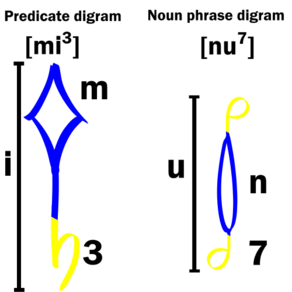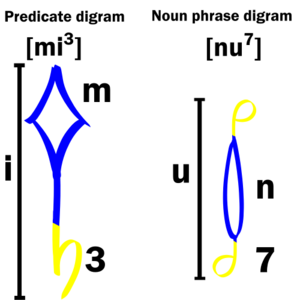Bundi language
The Bundi Language is a language first spoken by the Bundi tribe on Arbundia. It's the official language of the Arbundian Empire.
Phonology
The Bundi language has four vowels: ɐ, u, i, o̞ and 23 pulmonic consonants (used in words). There are 9 additional clicks and ejective consonants exclusively used as conjunctions prefixes.
Bundi words are usually composed of one-consonant/one-vowel syllables and always end with a vowel. One exception is the vowel o̞ is only found at the beginning of words and forms a syllable without consonants. All the vowels are pronounced short, unless for the last vowel of a proper name. Pitch plays a major role, each vowel can be pronounced as one of eight discrete notes, however some combinations note/vowel are not used in standard Bundi speech. Consonants are divided in 5 semantic categories. Changing a consonant from a category to another will change the meaning of the syllable. The pronunciation of the consonant will change depending on the place of the consonant from the end of the section; however the syllable will keep the same meaning. For example the syllable [n̥di] can only be found in the last syllable of a word, the syllable [ʀbi] will have the same meaning but can only be found one place before last. The first consonant of a word containing a noun is silent (pronounced [ħ]) unless it's from category 5. The first consonant of a word containing a verb is always pronounced fully. Ejective and click consonants are used alone as punctuation or connectors between sentences.
Consonants
| Pulmonic | Place → | Labial | Coronal | Dorsal | Laryngeal | |||||||||
|---|---|---|---|---|---|---|---|---|---|---|---|---|---|---|
| Manner ↓ | Bilabial | Labiodental | Alveolar | Velar | Uvular | Pharyngeal/epiglottal | ||||||||
| Nasal | m | n | ||||||||||||
| Plosive | ħp, p | ħb | n̥t | n̥d | ɡ | q | ʡ | |||||||
| Sibilant affricate | ts | dz | ||||||||||||
| Non-sibilant affricate | p̪fː | kxː | ||||||||||||
| Sibilant fricative | s: | z | ||||||||||||
| Non-sibilant fricative | ɸː | β, ħv | f | xː | ħ | |||||||||
| Trill | ʀb,ʀv | |||||||||||||
| Ejective | Stop | ʡʼ | |||
|---|---|---|---|---|---|
| Affricate | t̠ʃʼ | ʈʂʼ | kxʼ | qχʼ | |
| Click | kǀ | kǃ | kǂ | kǁ | |
Morphology
The Bundi language is agglutinative, words are composed of various morphemes that can be isolated with a specific meaning (each syllable has nearly always a own meaning). The meaning is conveyed by the consonant category, the vowel and the pitch. Each word can be split in sections of maximum 6 syllables. Each one of this sections is a noun a verb or an adjective/adverb; the adjective/adverb always precedes the noun/verb to form a continuous word. So each word can be either the equivalent of a noun phrase or a predicate.
Verbs are built with a consonant prefix that specifies the object and a consonant suffix that specifies the the subject. The tense is is given by the pitch of the verb; all the verb always has the same pitch however adverbs will have an independent pitch.
Writing System
 The Bundi language is written with the Arbundian script. This system was invented from scratch by Arbundi with the help of the Akavintu. It's an alphabetical system where each syllable is written by composing two symbols, forming a digram. The "Tail" conveys the pitch of the vowel, while the pronunciation of the vowel is determined by the height of the digram; the "Stalk" represents the consonant category, its pronunciation depends on its position from the end of the section. Digrams in predicates are written with only one tail on the bottom of the stalk; on the other hand diframs in noun phrases are written with a tail at each end of the stalk pointing at opposite sides. Words are written horizontally left to right or right to left, to emphasize proper noun phrases they are written in double with the second sequence mirrored. In the traditional script digrams of the same section of a word are written attached by their bottom tail, this facilitates pronunciation.
The Bundi language is written with the Arbundian script. This system was invented from scratch by Arbundi with the help of the Akavintu. It's an alphabetical system where each syllable is written by composing two symbols, forming a digram. The "Tail" conveys the pitch of the vowel, while the pronunciation of the vowel is determined by the height of the digram; the "Stalk" represents the consonant category, its pronunciation depends on its position from the end of the section. Digrams in predicates are written with only one tail on the bottom of the stalk; on the other hand diframs in noun phrases are written with a tail at each end of the stalk pointing at opposite sides. Words are written horizontally left to right or right to left, to emphasize proper noun phrases they are written in double with the second sequence mirrored. In the traditional script digrams of the same section of a word are written attached by their bottom tail, this facilitates pronunciation.
| "Stalks" | Romanized [IPA] | |||||
|---|---|---|---|---|---|---|
| Position→ | Last | -1 | -2 | -3 | -4 | |
| Consonant
Category |
d | nd [n̥d] | rb [ʀb] | rv [ʀv] | g [g] | z [dz] |
| t | nt [n̥t] | hb [ħb] | hv [ħv] | / | sz [ts] | |
| n | n [n] | hp [ħp] | vf [β] | k [q] | s [z] | |
| m | m [m] | p [p] | f [f] | kh [kxː] | / | |
| f | / | pff [ɸː] | ff [p̪fː] | hc [ʡ] | ss [s:] | |
| "Tails" | Vowel → | A | U | I | O |
|---|---|---|---|---|---|
| Frequency↓ | Relative digram height | ||||
| 1 | 1st=x | / | 4,5 | / | 7=o_ |
| 2 | 2nd=x+x/8 | 2 | 4,5 | 6,5 | / |
| 3 | 3rd=x+x/4 | 2 | 4,5 | 6,5 | / |
| 4 | 4th=x+3x/8 | 2 | 5 | 6,5 | / |
| 5 | 5th=x+x/2 | 3 | 5 | 7 | / |
| 6 | 6th=x+5x/8 | 3 | 5 | 7 | / |
| 7 | 7th=x+3x/4 | 3 | 5 | 7 | / |
| 8 | 8th=x+7x/8 | 3 | / | 7 | / |
Grammar
vt3a xt2i t2u vt3a f5i f6u .,;;;,.,.,t1um5id3a d4ud4ixd4ixd4u xd3a xm5ixt1u t7ut7i
